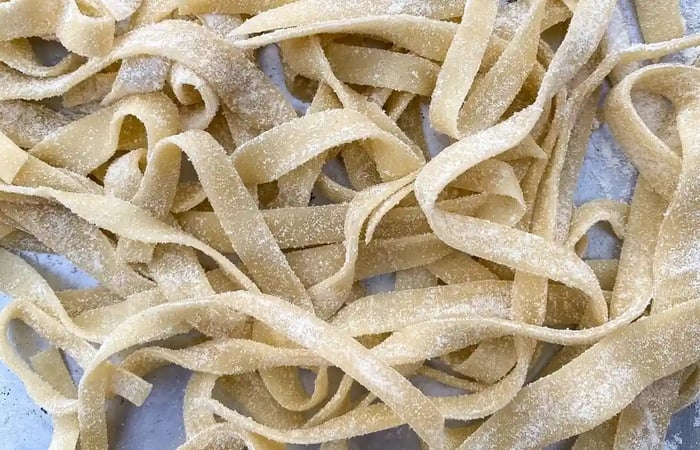 Photo: Sarah Ottino
Photo: Sarah Ottino
Recipe for homemade vegan pasta by Sarah Ottino
This homemade vegan pasta is one of my favorite things to make during a relaxing Sunday. It's a little bit of work, but is worth it in the end when you take a bite of this deliciously fresh pasta.
Traditional pasta is made using eggs, so I tried many different egg substitutes (flaxseed eggs, JUST eggs(, egg replacers, etc.). After lots of trial and error, I learned that simply using no egg is the best!
Though if you do want that egg flavor, you can add a tiny pinch of kala namak (black salt) and turmeric for color to the dough. This vegan pasta is also perfect without any adjustments. Summon your inner Italian chef and try this out today!
See also: Creamy Roasted Pumpkin Pasta Recipe
Serves: 4
Prep time: 20 minutes
Cook time: 3 minutes
Total time: 1 hour 10 minutes
Equipment needed
A rolling pin, clean surface
A pasta machine or a pizza cutter if you don’t have one
A baking sheet sprinkled with flour / or a pasta drying rack
Ingredients
2 cups of white flour
2 tbsp extra virgin olive oil
1/4 cup water
1 tsp salt
Method
Place the flour in a large bowl or on a clean countertop. Using a fork or your fingers, create a well in the center of the flour.
Add the olive oil, water, and salt to the well in the center of the flour pile.
Using a fork, slowly start to whisk the olive oil, water, and salt together. The flour will begin to mix in. Expand your strokes with the fork little by little to incorporate more flour.
Continue using a fork to mix all the flour and liquid ingredients together. It may seem very dry, but it'll come together eventually. This beginning process should take maybe 2-3 minutes.
Once the flour is too dense to mix with a fork, start to use your hands.
Smush the flour mixture with your fingers and palms to begin to knead the dough together. It will be messy! This should take maybe 1-2 minutes.
If the dough is not coming together, add a tiny bit more water. Don't add too much, only add about 1 tbsp at a time. If the dough is too wet, add a sprinkle of flour.
When the dough can form a very rough ball, it's time to knead. If you're working in a bowl, place the dough on a clean countertop now.
Knead the dough with the palms of your hands for 10 minutes minimum. The dough will get smoother and easier to work with as time passes.
Loosely wrap the dough in some plastic wrap and let it rest for 30 minutes minimum.
While the dough is resting, prep your workstation.
Once the dough has rested, unwrap it (don't throw away the wrap) and cut it into fourths.
Take one of the fourths out, and re-wrap the rest so it doesn't dry out.
Time to roll the dough!
If you're using a rolling pin, roll the dough out to about 1/4 cm, basically as thin as possible. Whatever shape it comes out in is fine, whether that's a long oval, circle, rectangle, or giant blob.
If you're using a pasta maker, start on the widest setting and roll it twice. Then narrow the setting by 1 number, roll the dough once, and repeat. Do this until you're at the second-to-thinnest setting.
Cut your pasta with either the fettuccine setting on your machine. If you’re using a pizza cutter, cut them to about 1/2 cm wide. It's okay if not all the pieces are exactly the same width or length.
Place the cut pasta on your baking sheet and toss it around to coat it in the flour (the flour is necessary so the pasta doesn't stick), or on your drying rack (no flour necessary).
Continue to roll and cut the rest of your pasta dough.
When you're ready to cook, bring a large pot of water to a boil on the stove.
Cook the pasta for 1-3 minutes, then strain.
Serve immediately with your favorite pasta sauce.







